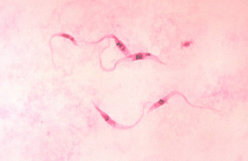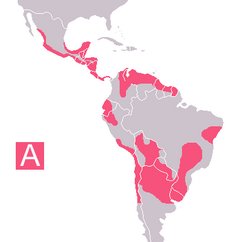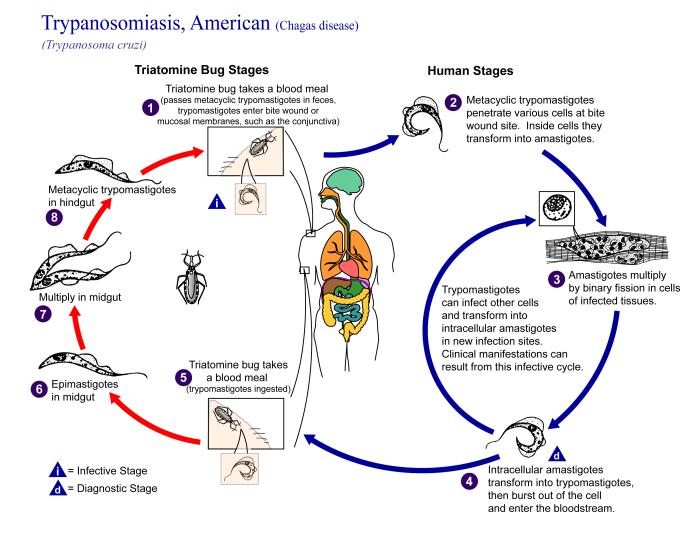SUMMARY
In this article, we evaluate electrocardiographic (ECG) alterations among urban workers from a mechanical-metallurgical industry in São Paulo, Brazil. In a cross-sectional survey carried out in 1980, we found 2.2% positive serological testing for Trypanosoma cruzi infection among 27,081 workers. A comparison between seropositive workers and a random sample of seronegative workers frequency-matched by age and occupation revealed that seropositive workers had a much lower educational level, and that a higher proportion of seropositive workers had ECG abnormalities (42.7%) when compared to those negative for T. cruzi infection (19.8%). The high frequency of ECG abnormalities suggests the need to provide medical assistance to these workers, without any kind of discrimination and to bring in a form of management that would decrease this dangerous risk to the workers and people around them.
KEYWORDS: Chagas disease; Cardiomiopathy; Cross-sectional study, Industrial workers.
INTRODUCTION
American trypanosomiasis, also known as Chagas disease, is an endemic zoonosis caused by the protozoan parasite Trypanosoma cruzi6, whose life cycle involves mammalian hosts (including humans) and insect vectors (various species of triatomines5). This typical tropical disease is found throughout the American continent, from the south of Argentina to the south of the USA11. The process of urbanization occurring in Latin America has changed the geographic distribution of Chagas disease. This urbanization is also responsible for the development of newer and important ways of transmission.
A survey by the Pan American Health Organization indicates 16 to 18 million people infected with the parasite on the American continent and 90 million exposed to the risk of being infected". In Brazil, it is estimated that about 5 million people were infected in the 1980's8. Over recent decades, there lias been a large increase in the number of infected people living in urban areas. This increase has been mainly due to migration from rural areas19, and secondarily to blood transfusion16.
The most important clinical manifestation of Chagas disease is cardiac. Electrocardiographic (RCG) changes seem to be the most common heart alteration in this disease21. The great majority of studies on BCG changes among individuals infected with T. cruzi have been conducted in rural endemic areas or clinical settings7. The aim of the present research was to evaluate ECG alterations related to Chagas disease among urban workers in a mechanical-metallurgical industry. We also investigated whether time of residence in a rural area during the first five years of life was associated with ECG alterations.
SUBJECTS AND METHODS
A cross-sectional survey for American trypanosomiasis infection was carried out in 1980 among urban workers from a mechanical-metallurgical industry of the Metropolitan Area of São Paulo, Brazil9. Wc screened 27,081 workers from this industry with a blood sample collected by linger prick onto filter paper; eluatcs were tested for antiTrypanosoma cruzi antibodies using immunofluorescence. The seropositive and a random sample of seronegative workers in the first test were invited to have a new blood sample collected by venopuncture. The seronegative (approximately 2:1) were frequency-matched to seropositive workers by age and occupation. Only eight women were seropositive; they were excluded. Participants were interviewed using a standardized questionnaire, and an electrocardiogram was performed, with five complex in median per derivation and a long D2 with twenty complex in median.
At a second stage, three serological tests for T. cruzi infection were performed on the blood samples: immunofluorescence2, hcmagglutination3 and complement fixation18. Individuals found positive in two or three of the tests were considered seropositive for T. cruzi infection. Those negative in all three serological tests were classified as seronegative.
Electrocardiograms were recorded in 12 standard derivations (long D2) with the subject at rest. They were independently interpreted by two of us (MG, JBN), without knowledge of the serological status. In those cases involving disagreement between the two readers, electrocardiograms were reviewed by both to reach a final classification.
Chi-square for linear trend was used to test statistical significance between seropositive and seronegative workers according to educational level. To estimate the association between seropositive and ECG abnormalities, odds ratios (OR) with 95% confidence intervals (95% CI) were calculated using non-conditional logistic regression1 (Stata Corp. Stata Statistical Software: Release 6.0. College Station, TX. Stata Corporation).
RESULTS
The first screening of the 27,081 workers found 591 (2.2%) individuals with positive serological test onto filter paper for T. cruzi infection. At the second stage, we recovered 373 seropositive workers. The seropositive workers were slightly older (mean = 35.5 years; median = 34.0) than the seronegative workers (mean = 34.2; median = 33.0). The distribution by age-group and educational level is shown in Table 1. Workers infected with Trypanosoma cruzi had a much lower educational level than seronegative workers (χ^sup 2^ for linear trend = 50.89, p
A higher proportion of seropositive workers had ECG abnormalities when compared to those negative for T. cruzi infection. Some alteration was found in 156 (42.7%) of the seropositive and in 110 (19.8%) of the seronegative cases (Table 2). A large difference was observed in all age groups, especially among workers less than 40 years old. The OR of any ECG abnormality associated with seropositivity, adjusted for age and educational level, was 3.05 (95% CI 2.23 - 4.17).
Five types of ECG alteration (complete right bundle branch block - CRBB -, left anterior hemiblock - LAH -, ventricular extrasystoles - VE -, 1st degree A-V block - ast AVB - ventricular repolarization alteration -VRA) were associated with T. cruzi infection after adjustment for age and educational level (Table 3). The strongest association was observed with CRBB (OR = 34.40, 95% CI 10.41 - 113.67). No other ECG alteration type was found with a significant difference between seropositive and seronegative individuals. We did not observe inactive myocardial areas.
A possible effect of time spent living in an endemic area for heart damage was investigated in the seropositive group. The presence of any ECG abnormality did not differ according to the number of years spent in a rural region during lhe first five (Table 4) or ten years of life (data not shown). Nor was any association either was found with regard to the most frequent ECG alterations.
DISCUSSION
Cardiopathies are the most important manifestations of Chagas disease and they can be measured by the electrocardiogram. Many studies have shown that there arc strong associations between certain specific alterations and this trypanosomiasis4,8,12,14. The findings in this study agree with earlier research in the field demonstrating a statistically significant higher prevalence of any kind of ECG abnormality in seropositive than in seronegative for T. cruzi infection. The specific types of ECG alterations related to the infection were VE, CRBB, LAH, 1st AVB and VRA. We found higher prevalence of ECG alterations in all age groups. The high prevalence of ECG alterations in seropositive workers under 40 years of age confirms a relatively short incubation period for development of chronic Chagas cardiomyopathy.
Specifically, CRBB is the most characteristic alteration in the electrocardiogram of individuals with Chagas cardiopathy. In addition, this alteration has a great importance because it represents, among others one of the leading cause of mortality14.
We detected that urban workers infected with T. cruzi have precocious ECG alterations when compared with seronegative workers. These alterations are of particular importance since they are, frequently, the first manifestations of Chagas disease, although they do not lead to clinical symptoms. In this situation, healthy urban workers infected with T. cruzi could be unaware of their clinical status, especially the cardiac. Exposure to heavy and dangerous activity at work could worsen the course of the disease10.
Our study corroborates previous data indicating that seropositives for T. cruzi have a higher risk of developing BCG alterations and, consequently, cardiopathy. Regarding the association of the infection with poor social-economic conditions, measured by educational level, these people are exposed to hard working conditions, especially in urban areas. We have shown that workers infected with Tiypanosoina cnizi had a much lower educational level than seronegative workers. This confirms previous observations.
A few factors have been postulated for the development of Chagas cardiopathy in infected individuals, including immunological factors, reinfections and physical exertion. MAGUIRE et al.12 investigated the possible effect of physical activity and time of residence in rural areas for the development of Chagas cardiopathy. We tried to correlate time of residence in an rural area (rural area considered as an indirect marker of an endemic area for Chagas disease) and cardiopathy, as measured by electrocardiogram, since more time in such area would lead to higher levels of parasitemia and a greater possibility of developing cardiopathy related to trypanosomiasis. According to these data, presence of positive epidemiological data, such as living in an endemic area in the earliest years of life, could be a reason for treatment, decreasing the viral load and the parasitemia, leading to less alteration in the cardiac muscle20. However, in this survey, in agreement to MAGUIRE et al.12, we determined that the number of years spent in an endemic region during the first five or ten years of life was not associated with cardiac manifestations, as indicated by ECG abnormality.
In conclusion, the high frequency of those manifestations found suggests the necessity of providing medical assistance to these workers15,17, without any kind of discrimination, and of bringing in a form of management that would decrease dangerous risk to the worker and the people around them.
RESUMO
Doenca do Chagas e alterações cletrocardiográficas entre trabalhadores industrials em São Paulo, Brasil
Neste artigo, analisamos a frequência de alterações elctrocardiográficas (ECG) em trabalhadores de indústria mccânico-metalúrgica de São Paulo, Brasil. Num estudo transversal, conduzido em 1980, cncontramos 2,2% de reações sorológicas positivas para infecção pelo Trypanosoma cruzi entre 27.081 trabalhadorcs. Uma comparação entre trabalhadores soropositivos e uma amostra aleatoria de trabalhadores soronegativos parcados por frequência em idade, e ocupação mostrou que os trabalhadores soropositivos apresentam menor nível de cscolaridade e maior proporção de alterações ECG (42.7%) quando comparados aos soronegativos para infecção pelo T. cruzi (19.8%). A alla frequência de alterações ECG sugerc a nccessidade de oferecer assistência médica para esses trabalhadores, destituída de qualquer tipo de discriminação, criando condições para diminuir os riscos para esses trabalhadores e os indivíduos próximos.
REFERENCES
1. BRESLOW, N.H. & DAY, N.E. - Statistical methods in cancer research: the analysis of case-control studies. Lyon, International Agency for Research on Cancer, 1980. v. 1. (Publication No. 32).
2. CAMARGO, M.E. - Fluorescent antibody test for the serodiagnosis of American Trypanosomiasis. Technical modification employing preserved culture forms of Trypanosoma cruzi in a slide test. Rev. Inst. Med. trop. S. Paulo, 8: 227-234, 1966.
3. CAMARGO, M.E.; HOSHINO, S. & SIQUEIRA, GRV. - Hemagglutination with preserved sensitized cells, a practical test for routine serologic diagnosis of American trypanosomiasis. Rev. Inst. Med. trop. S. Paulo, 15: 81-85, 1973.
4. CASTRO. C.; PRATA, A. & MACEDO. V. - Estudo clínico durante 13 anos de 190 chagásicos crônicos de Mambaí. Goiás, Brasil. Rev. Soc. bras. Med. trop., 34: 309-318, 2001.
5. CARVALHO, M.E.; SILVA, R.A.; RODRIGUES, V.L.C.C. & OLIVIERA, C.D. - Programa de controle da doença de Chagas no Estado de São Paulo: sorologia de moradores como porte de investigação de unidades domiciliares com presençn de triatomíncos vetores na década de 1990. Cadern. Saúde públ. (Rio de J.), 18: 1695-1703, 2002.
6. CHAGAS, C. - Nova tripanozomiaze humana: estudos sobre a moriologia e o ciclo evolutivo do Schizotrypanum cruzi n. gen., n. sp., ajente etiolójico de nova entidade morbida do homem. Mem. Inst. Oswaldo Cruz, 1: 159-218. 1909.
7. COURA. J.R.; BORGES-PEREIRA, J.; ALVES FILHO. F.I. et al. - Morbidity of Chagas' disease in areas of Sertão da Paraiba and Caatinga do Piaui. Rev. Soc. bras. Mcd. trop., 29: 197-205. 1996.
8. FERREIRA, M.S.; LOPES, E.R.; CHAPADElRO. E.; DIAS. J.C.P. & OSTERMAYER, A.L. - Doença de Chagas. In: VERONESI, R. Tratado de Infectologia. São Paulo, Atheneu, 1996. p. 1175-1213.
9. GOLDBAUM, M, - Saúde e trabalho: a doença dc Chagas no setor Industrial. São Paulo. 1981. (Tese de doulorado - Faculdade de Medicina da Universidade de São Paulo).
10. GUARIENTO, M.E.: CAMILO, M.V.F. & CAMARGO, A.M.A. - Working conditions of Chagas' disease patients in a large Brazilian city. Cadcni. Saúde públ. (Rio de J.), 15: 381-386. 1999.
11. KIRCHOFF. L.V. - American trypanosomiasis (Chagas' disease): a tropical disease now in the United Stales. New Rug. J. Mcd., 329: 639-644. 1993.
12. MAGUIRE. J.H.; HOFF, R.; SHERLOCK. I. et al. - Cardiac morbidity and mortality due to Chagas' disease: prospective electrocardiographic study of a Brazilian community. Circulation, 75: 1140-1145, 1987.
13. PAN AMERICAN HEALTH ORGANIZATION - Health conditions in the Americas. Washington, PAHO, 1994, p. 147-149. (Scientific Publication No. 549)
14. PRATA, S.P.; CUNHA, D.F.; CUNHA, S.S.F.; PRATA, S.C. & NOGUEIRA, N. - Prevalência de alterações cletrocardiográficas em 2000 pacicnlcs chagásicos idosos e não idosos. Arq. bras. Cardiol., 60: 369-372, 1993.
15. RAMOS Jr., N.A. & CARVALHO, D.M. - Os difcrentes significados da ccrtificação conferida ao Brasil como estando livre da üoenca de Chagas. Cadern.
Moisés GOLDISAUM(1), Fabio Yoshito AJIMURA(1), Júlio LITVOC(1), Silvino Alves de CARVALHO(2) & José ELUF-NETO(1)
(1) Departamento de Medicina Preventive, Faculdade de Medicina da Univcrsidade de São Paulo, SP, Brasil.
(2) Departamento de Doenças Infecciosas e Parasitárias, Faculdade de Medicina da Univcrsidade de São Paulo, SP, Brasil.
Correspondence to: Moisés Goldbaum, Dcpartamento de Medicina Preventive, Faculdade de Medicina da Universidade de São Paulo, Av. Dr. Arnaldo 455, 2° andar, 01246-903 São Paulo, SP, Brasil, e-mail: mgoldbau@usp.br
Copyright Instituto de Medicina Tropical de Sao Paulo Nov/Dec 2004
Provided by ProQuest Information and Learning Company. All rights Reserved




